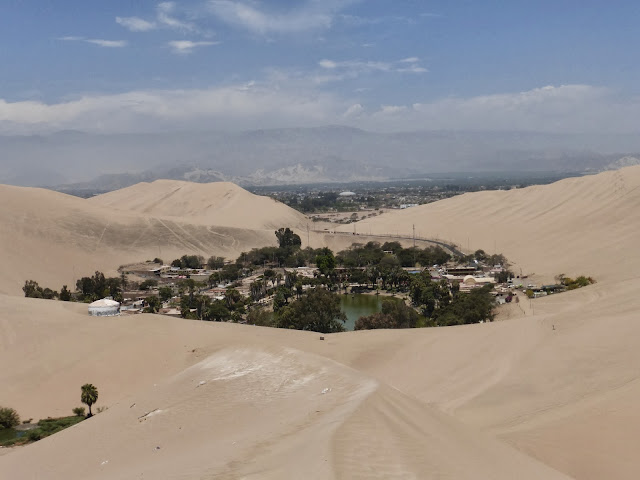 |
| From the top of a sand dune, a view of Huacachina, with the city of Ica in the background |
"Does that come with asparagus?", inquires Steven, an English tourist who is spending the day in Huacachina, hoping to catch a sand buggy ride through the majestic dunes of Ica.
He is contemplating ordering the arroz chaufa, one of the few traditional Peruvian dishes available in the restaurant Desert Nights. Most gringos (the South American term for Western tourists) tend to order burgers and fries, or beer and chicken wings.
 |
| A buggy carries tourists to the top of a dune for some sand surfing |
Here is the irony: according to The Guardian, a study conducted in 2010 revealed that industrial production of asparagus in Peru's Ica valley, a large portion of which is sent overseas to the English market, is depleting the area's water resources so fast that smaller farmers are finding wells running dry.
Steven was unaware of this.
In 2012, the National Water Authority (ANA) confirmed that water shortages in the Ica region have caused major agricultural firms to move to Northern Peru.
Yet, in the midst of this dryland glows the lake of Huacachina, the only oasis in South America.
"Huacahina was discovered in the 1900s by the Italian Angela de Peroti. She found out that the water there had medicinal properties, like curing rheumatisms and skin diseases.", says Pablo, a tour guide in Huacachina. "There was a time where there were seven lakes in the Ica region. Out of those seven, Huacachina is the only one left.", he says.
 |
| Farmers collecting water from a well (courtesy of The Guardian) |
It is said that in 2008, the water level diminished by five metres in two months.
Despite the two or three scattered signs asking visitors to "respect the environment", the majority of them (especially the gringos) seem to be gleefully unaware of the ecological footprint their stay in Huacachina induces.
After having sand surfed for a few hours, tourists go have a shower in one of the eleven hostels surrounding the oasis. They brush their teeth and wash their clothes anytime they wish.
They could not appreciate this unlimited access to water without knowing that 5 km away, in the city of Ica, restrictions abound. "In certain districts, residents only have access to water four hours a day. Two in the morning, and two at night.", says Eduardo, a tourist agency owner who lives in Ica.
Does this imbalance not infuriate the residents of Ica?
 |
| Some gringos at Desert Nights, where the ´menu del dia´ consists of burgers and fries |
Christopher, an English traveler, was astounded to find out about this issue. "It´s not right... but I guess they´re still making money off of us. And I don´t think our presence here affects the restrictions in Ica. They would probably still be there". After a moment´s reflection, he adds: "But yeah, there should be more information around about this problem.".
Matheo, who works at the hostel Desert Nights, did not wholeheartedly embrace this suggestion. "Most people here come for a day or two. 80% are gringos, and very few speak Spanish. We cannot force restrictions upon these vacationers. There is a sign on the bathroom door that says that water is a scarce resource here in the Huacachina desert.", he says.
Despite ecological concerns, there is a consensus among the Peruvian workers in Huacachina that tourism is extremely beneficial to the region. "If there were no tourists, many people in Ica would be unemployed", says Richard, a tour guide from Ica. "The average salary for Peruvians is 700 soles a month (250$). Here, we earn between 1500 and 2000 soles.", he explains.
I definitely had mixed feelings about staying in Huacachina. The empty sand dunes early in the morning and around sunset time are what kept me there for three days (OK, the sand surfing was pretty amazing too!). I found out about the water scarcity issue on my last day. It´s something to be aware of...
 |
| From top left: Richard, Pablo, Eduardo and Marcos. All four work as tour guides in Huacachina. |
Sand showers after sand surfing...why not.
ReplyDeleteCheers